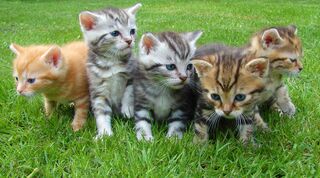Animal Behavior
Cats Deserve to Be Happy—Here's How to Enrich Their Lives
Zazie Todd's new book is a must-read for all people who want to know about cats.
Posted April 29, 2022 Reviewed by Ekua Hagan
Key points
- Cats are often misunderstood and therefore need more from the humans they live with.
- Pet cats need an appropriate home set-up to thrive, such as a sturdy scratching post that they like.
- Pet cats can be trained to handle necessary events such as going in the carrier and a visit to the vet.

I love cats and wish I weren't allergic to 99% of these amazing, mysterious, and deeply emotional nonhumans with rich inner lives. Because my personal time with cats is very limited, I go to the experts, and Dr. Zazie Todd is one of my go-to people about the behavior of these wonderful beings—who have wrongly been characterized as psychopaths when they're just being cats—and how to give them the very best lives possible in a human-oriented world.
I'm pleased Zazie could answer a few questions about her new book, Purr: The Science of Making Your Cat Happy. Among other topics, her discussions of misleading myths about cats, the importance of play, end-of-life/quality-of-life decisions, and how lab studies don't necessarily reflect what homed cats actually experience are exemplary. Here's what she had to say.
MB: Why did you write Purr: The Science of Making Your Cat Happy?
ZT: I knew when I started writing my first book, Wag: The Science of Making Your Dog Happy, that I would want to write a follow-up about cats. Cats are popular pets for a reason—they’re very special creatures—but they are also much misunderstood. When people have a better understanding of cat behavior and know what their cat’s needs are, then they can have a better relationship with their cat. There are lots of people who really love their cat and would like to know more about how to make their cat happy—this book is for them.

MB: How does your book relate to your background and general areas of interest?
ZT: I have always loved cats! My background is in psychology, and I’m an animal behavior expert specializing in cats and dogs. I’m a member of the iCatCare Feline Wellbeing Panel and I’ve been writing about how to use science to have happier cats and dogs at my Companion Animal Psychology blog since 2012. I especially love providing evidence-based tips that will help people with their pets.
MB: Who is your intended audience?
ZT: Purr is for everyone who loves cats. It would make a great gift for dedicated cat guardians who would do anything for their cat. It’s also a great introduction for someone who is new to cats because it will help them get things right from the start.
MB: What are some of the topics you weave into your essay and what are some of your major messages?
ZT: The main message is that pet cats need more from us. Everyone thinks cats have it easy, but we know that the biggest welfare issue for pet cats is behavior issues because their home environment is not right for them. There are many things we can do to make life better for cats, including setting our home up right, and when we do that, they are much less likely to have behavior issues. For example, many people don’t provide sturdy scratching posts that their cat likes, but then complain when their cat scratches the furniture. Scratching is a normal behavior for cats, so it’s essential that we provide them with appropriate surfaces to scratch on. The social behavior of cats is also poorly understood, and as a result, many people get hissed at or bitten when they think they are being affectionate to their cat!
Another theme is that good welfare isn’t just about avoiding bad experiences; it’s also about providing good experiences. And this is where we can have a lot of fun with our cats! Making more time for playing with a wand toy, teaching cats how to use food puzzle toys, and providing other enrichment activities is great fun for us as well as for our feline friends. (See my answer to the last question for more on this.)
Finally, it’s also important to know that cats can be trained. That doesn’t just mean teaching them neat tricks (although that is a fun activity). Training can help cats with things that have to happen, like going in the carrier and for a visit to the vet. Of course, it’s easier if you, start with a kitten, but even adult cats who are terrified of their carrier can be taught—very gradually—to like it, and it makes such a difference to them. And to you, because you no longer have the experience of your cat running to hide in an inaccessible space as soon as they see their carrier!
MB: How does your book differ from others that are concerned with some of the same general topics?
ZT: Purr takes you through from getting a kitten or cat, setting your home up for them, what we mean to our cats, taking them to the vet, making time for play, caring for senior cats and those with special needs, right through to making those difficult decisions at the end of a cat’s life. Every chapter explains what we know from science and ends with a list of tips. Stories about my own cats, Harley and Melina, are woven throughout the book. The book ends with a checklist for a happy cat and two training plans (one for a neat trick to teach your cat, and the other to teach your cat to like going in their cat carrier).
MB: Is there anything else you'd like to tell readers?
ZT: I’ve written a fun mini-course with five activities to try with your cat. You can work through it in your own time and each activity has different levels, so if there’s one that your cat especially enjoys, you can keep it going.1
References
In conversation with Dr. Zazie Todd.
1) The course is available for free to anyone who pre/orders a copy of Purr by midnight PT on May 27th.
Bekoff, Marc. Are Some Cats Psychopathic, or Are They Just Being Cats?
_____. What Your Cat Needs You to Know. (How to enrich their cognitive, social, and emotional lives.)
_____. Are Cats More Socially Inept Than Dogs?
_____. Dogs and Cats: Their Brains, Faces, Blinking Eyes, and Us.
_____. The Cat-Human Relationship and Factors That Affect It.
_____. Dogs, Cats, and Humans: Shared Emotions Act As "Social Glue".
_____. The Inner Life of Cats Reveals Fascinating Feline Secrets.




